Florence Helena McGillivray
Florence Helena McGillivray (1 March 1864 – 7 May 1938), was a Canadian landscape painter. Though McGillivray's main talent lay in landscape painting, she also practiced painting in watercolour during her career. Her paintings depicted many locations on the Gatineau River, the Val-des-Bois, the Ottawa River at Fort-Coulonge and many more scenes of Canada and abroad.[1]
Florence Helena McGillivray | |
|---|---|
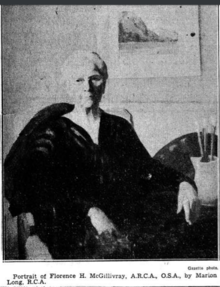 Florence H. McGillivray, 1937 | |
| Born | March 1, 1864 Township of Pickering, Ontario, Canada |
| Died | May 7, 1938 (aged 74) Toronto, Ontario, Canada |
| Nationality | Canadian |
| Education | Central Ontario School of Art, Academie de la Grande Chaumière |
| Known for | Painting |
Known for her Post-Impressionistic style, McGillivray in 1912, traveled to Paris to study. She was a well-known teacher.[2] McGillivray's modernist art included textured, painterly brushstrokes applied with the palette knife and compelling colour. McGillivray was a contemporary of the Group of Seven. She encouraged the influential Canadian painter Tom Thomson.
In the 1920s, McGillivray`s career exploded. Her art mainly was influenced by the Post-Impressionist and Fauvist movements. McGillivray lived in Whitby, Ottawa and Toronto but travelled often to pursue her work. She visited Europe, Alaska, Jamaica and Trinidad. Exhibition locations include Malloney's in Toronto, Continental Galleries, Montreal, and her own studio in her hometown.
The National Gallery of Canada, the Art Gallery of Ontario, the Art Gallery of Hamilton, the Agnes Etherington Art Centre and galleries in Oshawa, Whitby, Kitchener, London, and Windsor all hold her work in their collections. McGillivray was an Associate member of the Royal Canadian Academy of Arts and a member of many associations such as the Ontario Society of Artists, the New York Society of Women Painters and Sculptors, and the Canadian Society of Painters in Water Colour.[2] Florence Helena McGillivray died in Toronto on May 7, 1938, and is buried at Union Cemetery, Oshawa.
Early life
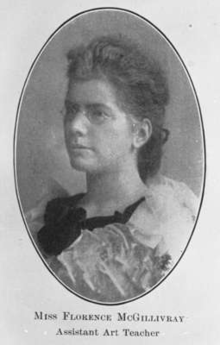
Florence Helena McGillivray was born in Pickering Township in Ontario on March 1, 1864.[3] She was the eleventh of thirteen children, and the youngest female of the Scottish immigrant farmer, George McGillivray (1813-1894) and his wife, Caroline Amelia Fothergill McGillivray (1828-1909).[4]
In 1870, the family moved to Inverlynn, a house located at 1300 Gifford Street in Whitby, Ontario. To this day, the property has remained in the possession of George McGillivray`s descendants. The children attended a grammar school in Whitby, and she had shown artistic talent in her early childhood years so she pursued her art by attending the Central Ontario School of Art (now Ontario College of Art), where she studied under Professor William Cruikshank. McGillivray then began taking one-on-one lessons from renowned Canadian artists such as Farquhar McGillivray Knowles and Lucius Richard O'Brien.[5]
Education
After studying at the Ontario School of Art, McGillivray had private lessons with J.W.L. Forster, Lucius O'Brien and Farquhar McGillivray Knowles.[6] During the decade of 1900, she worked as a teacher in Whitby at the Ontario Ladies’ College (now Trafalgar Castle School) and at Pickering College in Pickering, Ontario.[6]
In 1913, she went to France to continue her studies at the Academie de la Grande Chaumière under Lucien Simon and Émile-René Ménard.[7]
Artistic career
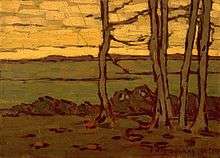
McGillivray specialized as a landscape painter. She had a brilliant and unusual handling of brushwork that created unique compositions.[6]
She was one of the first women artists to explore the landscape of northern Ontario and Quebec. She was part of the small group of artists that liked the romantic-realist view of the railway artists and the heroic view of the landscape in the 1890s that characterized the work of the Group of Seven and their adherents following the Great War.[8]
Throughout her life, she travelled across Canada, and to the United States, Jamaica, Trinidad, the Bahamas and Europe, as well as France, England and Italy, looking for new and challenging landscapes to paint.
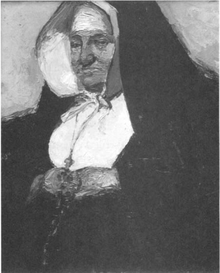
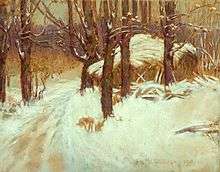
In 1913, while in Paris, McGillvray had her painting Contentment (1913) exhibited at the Salon des Beaux Arts in Paris, the first great achievement on her career. In the same year, she was also said to have been elected president of the International Art Union.[5]
McGillivray moved back to Canada in 1914. The most prolific and vibrant phase of her artistic career occurred during the 1920s while she lived in Ottawa, where she set up a studio at Frank Street. [iv] Her work from this period is rich in colour and texture, reflecting the Post Impressionist work she had encountered in Europe. [v]
She had a method of rendering forms in massed areas of colour applied in places with the palette knife and strong black lines around forms, a style seldom seen in Canada before her work.[9] This technique was sympathetic to Tom Thomson, who admired her and said of her, "she is one of the best".[9]
Three of her paintings are part of the National Gallery of Canada collection, Midwinter, Dunbarton, Ontario (1918), Afterglow (1914), and St. Anthony Harbour, Newfoundland, (1926).[10]
Exhibition
- 1913 Paris Salon des Beaux Arts, exhibited Contentment
- 1914 - 1935 exhibited with the Royal Canadian Academy of Arts
- 1917 - 1938 exhibited with the Ontario Society of Artists
- 1920 - 1930 exhibition venues included Malloney's in Toronto, Continental Galleries in Montreal; and artist's own Frank Street Studio in Ottawa
- 1924 British Empire Exhibition, Canadian Section of Fine Arts, Wembley, England
- 1927 Exposition d’art canadien, Musee du Jeu de Paume, Paris
- 1928 Exhibition of Paintings of At Home and Abroad by F.H. McGillivray, A.R.C.A., O.S.A., Art Association of Montreal
- 1970 retrospective exhibition, Whitby Arts, Whitby, Ontario
- 2002 The Birth of the Modern: Post-Impressionism in Canadian Art, c.1900-1920, Robert McLaughlin Gallery, Oshawa; travelled to Montreal, London (Ontario), Fredericton, and Winnipeg
- 2017 Finding Florence, retrospective exhibition, Station Gallery, Whitby, Ontario [11]
Affiliation
Florence Helena McGillivray was affiliated with a multiple of associations, groups and artists during her lifetime. One of the most famous groups that she was associated with was the Group of Seven. Her art works expresses a view of landscape in bold colours that would be categorized later on as part of the Group of Seven landscape painting that captures the two visions of the land: the romantic-realist view of the railway artists of the 1880s and the heroic view of the landscape in the 1890s.[5]
She joined the Women's Art Association of Canada where she studied painting on china with Mary Dignam, its founding president.[5] McGillivray was welcomed into communities and numerous social affairs which included the Society of Women Painters and Sculptors and the Women Painters and Sculptors Art Club (Women Painters and Sculptors 1917) which were both centralized in New York City.[1] She continued her study of painting on china with Marshall Fry in New York in 1898 and sold her pieces later from her studio in Whitby [5]. She also gave painting classes in Whitby.[5] She became an instructor and a critic at an all boys’ school in Pickering College and an assistant art instructor at the Ontario's Ladies’ College in the 1900s and later, the head of the art department.[12]
The artist also helped encourage fellow Canadian artist Tom Thomson, who was praised for his landscape paintings.[6] In 1913 during her trip in Paris, her instructors at the Académie de la Grande Chaumière were Lucien Simon and Émile-René Ménard. But her real inspiration was the artist Frédéric Fiebig[13] and due to him, she began to work in a style new to her that involved using the palette knife and a heavier application of paint. Her works of art in this mode were acknowledged and she was invited to display her paintings at the Salon des Beaux Arts.[1] Not long later, it is said, the artist was voted as president of the International Union.[6] In the later years of McGillivray's life she joined the Ontario Society of Artists (1917), she was elected an Associate member of the Royal Canadian Academy of Arts(1924),[5] and was a Charter member of the Canadian Society of Painters in Water Colour and its first woman member (1925). [12]
Influence and Style
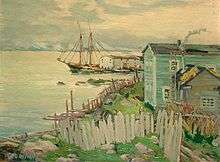
McGillivray traveled across Canada for inspiration.[5] She painted her environment using bold colours and the contour of shapes.[5] McGillivray's artistic style stressed the abstract qualities of lines, shapes and forms[5] that was expressed in her work through a large amount of paint applied using the palette knife in her oil paintings.[5] Working outdoors, the painter developed a powerful style that defined her career.[5]
Her inspiration derived from various environments[5] including her hometown of Whitby, and her travel to the Gatineau area,[2] as well as to Eastern Canada, including Newfoundland, and to Trinidad, Jamaica, Bahama Islands in the West Indies, Alaska, Eastern United States, Western Canada, Venice, Italy and the Swiss Alps.[1] She worked in many media which included watercolour, pastel and oil.[5] During her trip to Europe, she had encountered newly forming art styles of Symbolism and Post Impressionism that impacted and influenced her art. Her artwork is expressed mainly with vivid colours of contouring shapes and dabs of paint that simplifies the form of an object.[5]
Later Years
McGillivray traveled extensively in search of new landscape scenery to paint. In 1930, by then in her mid-60s, McGillivray bought a house in Toronto where she retired.[5] She continued to paint primarily from the sketches she had accumulated from around the world. As a landscape painter, McGillivray found some prestige and recognition while alive, but not quite as much as Thomson though she had encouraged him in his modernist path. Painting landscapes in a modernist style was not something expected from a woman in the early 1900s. McGillivray never married and left no children. She died at age 74 in Toronto, on May 7, 1938.[5]
References
- "Canadian Women Artists History Initiative : Artist Database : Artists : MCGILLIVRAY, Florence Helena". cwahi.concordia.ca.
- Unknown. "Florence Helena McGillivray, 1906". Retrieved March 9, 2017.
- Allen 2019, pp. 5-7.
- Allen 2019, p. 5.
- "A Bridge A-Building". www.gvhs.ca. Retrieved March 9, 2017.
- Parkash, A.K. (2008). Independent Spirit: Early Canadian Women Artists. New York: Firefly Books. p. 355. ISBN 978-1554074174.
- Allen reproduces the sign for the school on which Menard's name is given as "Andre Menard," p. 67. The name is more properly given as Émile-René Ménard (1862–1930)
- Tippett, Maria (1992). By a Lady: Celebrating Three Centuries of Art by Canadian Women. Toronto: Viking. ISBN 0140169555.
- Murray, Joan (1998). Tom Thomson: Design for a Canadian Hero. Toronto: Dundurn Press. pp. 76–77. ISBN 1550023152.
- "Midwinter, Dunbarton, Ontario. Florence H. McGillivray 1918". www.gallery.ca. Retrieved March 9, 2017.
- "Finding Florence". www.stationgallery.ca.
- "Florence Helena McGillivray, 1906". images.ourontario.ca.
- Allen, pp. 74-75
Sources
- Allen, Bill. "Up the Gatineau!" Following Florence XLII, 2016.
- Allen, W C. (2019). She is one of the best : a researcher's notes on the life and times of canadian artist Florence... McGillivray. [S.l.]: Tellwell Talent. ISBN 978-0-2288-0683-7. OCLC 1090427835.CS1 maint: ref=harv (link)
- Art Gallery of Ontario. "The Canadian Collection." Art Gallery of Ontario, 288-289. New York: McGraw-Hill Company of Canada, 1970.
- Canadian Women Artists History Initiative. 2016. Artist Database.
- Haggo, Regina, "Florence McGillivray Tamed Nature with a Brush" The Spectator (2017) Accessed January 2017.
- Royal Canadian Academy Annual Exhibition: (Montreal, November 18, 1937) "Royal Canadian Academy Show is Opened at Art Association. Portraiture Represented by Good Examples and Landscapes as Usual Predominate." Gazette (Montreal) November 19, 1937. P.12.
- Ten-Doesschate Chu, Petra and Touborg, Sarah. Nineteenth Century European Art. Upper Saddle, NJ: Pearson Education, 2006.
- Whitby Archives. 2016. Archives at Whitby Public Library.
Further reading
- Agnes Etherington Art Centre (2008), Permanent collection, 1968, University of Michigan
- Art Gallery of Ontario (1970), Art Gallery of Ontario: A Canadian Collection, McGraw-Hill Company of Canada, ISBN 9780070925045
- W.C Allen (2016), A Collection of Works by Florence Helena McGillivray, Friesen Press, ISBN 9781460285718